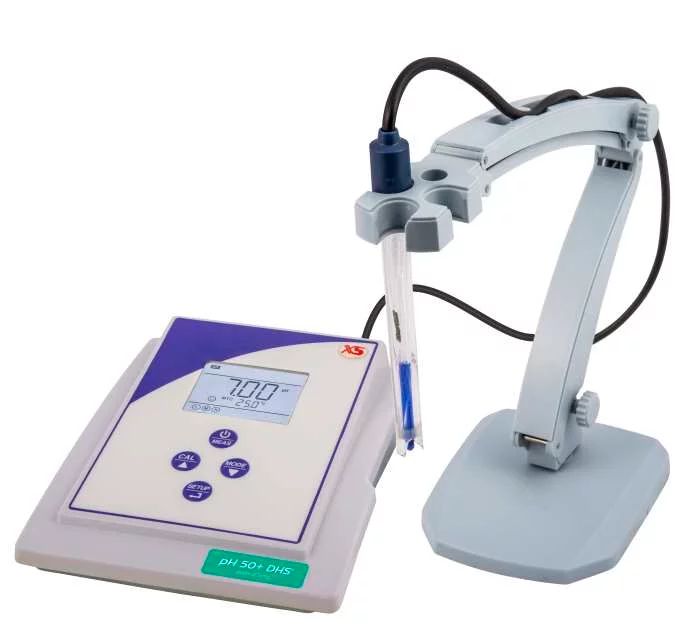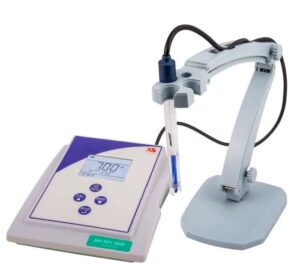We are specialists in measurement technology. We are here to help you with Aw value meters, data acquisition, displays, hand-held meters, infrared temperature meters or climate sensors.
In this manual, we share information and tips on pH meters.
If you need further information or would like individual advice about the best measuring solution for your issue, then please contact Mieke de Kunder. She’d be happy to advise you. Call: +31 6 28382690 or send an email to m.dekunder@pedak.nl
- Choose the right meter and electrode
- General maintenance tips for the pH meter
- Calibration of the pH meter
- Problems with calibration
1. Choose the right meter and electrode
The right meter
If you wish to measure several values, then it may be wise to choose a meter that can be connected to different electrodes. Besides electrodes that measure pH value, multimeters let you connect temperature probes, Ion-selective electrodes, Redox probes, etc.
For example, if you need to measure the conductivity of salt, then our range includes a suitable meter to do just that. We’d be happy to advise you.
This manual focuses on pH meters.
The right electrode for your pH measurement
The choice of electrode depends on the product or substance whose pH value you need to measure.
For example, an electrode with a pointed tip is designed to measure the pH of sausages or other solid products or substances, whereas a rounded electrode is better for liquids.
2.General tips on maintaining the pH meter electrodes
The electrode is the most vulnerable part of the pH meter. Regular maintenance of the electrode is not only essential for delivering accurate measuring results, it also extends its lifespan.
These tips will ensure you get the most out of your pH meter for a long time:
- Always use storage solution;
Keep your pH electrode in storage solution and ensure it always remains moist. Do not store the electrode in demineralised water or other liquids as these are not suitable. - Never touch the electrode with your bare hands;
This can damage the electrode which could cause discrepancies in your measuring results. Therefore, always wear gloves. - Clean the electrode after use;
- With demineralised water: rinse the electrode with demineralised water and keep it in storage solution when not in use.
- With cleaner: the electrode has tiny holes that can become blocked causing it to give false readings. It is therefore important to regularly hang the electrode in a cleaner. We recommend the following two cleaners:
- pH Cleaner A Pepsin (max. 15 minutes). This cleaner dissolves any proteins that may be stuck to the electrode.
- pH Cleaner D Pedak (max. 1 hour). This cleaner removes fats and oils from the electrode.
- The electrode is made of glass and therefore breaks easily. You can prevent damage by using an adjustable electrode holder.
3. Calibration of the pH meter
How do I calibrate my pH meter?
Calibrating a pH meter goes as follows:
- If necessary, clean the electrode with cleaning fluid
- Use fresh buffer fluid with the right pH values for each calibration.
Pay close attention to the shelf life of your calibration solutions.
- Always start your calibration with pH 7. From there you can proceed to the appropriate lower or higher value. For example, if you need to calibrate pH 10, start with pH 7 and then proceed to pH 10.
STEP 1
Rinse the electrode thoroughly with demineralised water and place it in the pH 7 buffer solution.
The pH meter will now give a reading. The further away the reading is from pH 7, the greater the inaccuracy of the measuring instrument.
It is not a problem if your meter shows a measuring error. By calibrating and adjusting (step 2) the instrument you can make sure that your readings are accurate and reliable.
STEP 2
Follow the instructions that came with the meter to calibrate and adjust it.
Rinse the electrode with demineralised water and calibrate the next point.
Calibrate at least two points.
Once you have calibrated the instrument, you can start taking readings.
Place the electrode in storage solution after use.
How often do I need to calibrate my pH meter?
If you are unsure often you need to perform a calibration, place the electrode in the buffer solution with the appropriate pH value. If the meter shows the correct pH value, then calibration is not necessary. If you make a note of how many readings it takes before the values start to deviate, then you will know when you need to perform a calibration.
The longer the meter is used, the older the fluids in the electrode become and the more measurement errors will occur. You may also need to calibrate the instrument more often according to how you use it and the type of products you measure. We recommend performing a calibration at least twice a month.
When do I need to calibrate more often?
- If you want to take accurate measurements; you can calibrate the instrument every day.
- When using a new electrode for the first time.
- After taking a reading in a highly concentrated solution.
- If you are going to use an older electrode.
4. Problems with calibration
If your measurement is unstable or slow or if the pH value keeps fluctuating,
then the possible causes and solutions are as follows:
- The electrode is damaged; replace the electrode.
- The electrode may be dirty; clean it with cleaner A and/or D
- The sensor cable may be damaged or is not properly connected to the hand-held meter or bench meter. Check the connection, repair or replace the cable if necessary.
- Avoid interference from electrical signals in the immediate vicinity, e.g. from a pump. These can interfere with the mV signal from the electrode.
- The electrode is too dry causing pH values to vary too much to be read. Place the sensor in the storage fluid for a few hours and try again.
- Buffer fluid has expired or has already been used once. Replace the buffer fluid.
There are errors in the measurement results
According to the specifications, measuring equipment may show errors. By measuring equipment, we mean the two buffer solutions, temperature readings, the pH electrode itself and the hand-held device.
The final error is the sum of the whole measuring system.
In the worst case, the error may be ± 0.05:
Buffer fluids 1: ± 0.01
Buffer fluids 2: ± 0.01
Temp measurement: ± 0.01 (depending on temperature and pH value)
pH electrode: ± 0.01
pH meter: ± 0.01
In practice, an accuracy of 0.03 can be expected.
The repeatability of a measurement is approximately 0.01.
Do you have any questions or are you still experiencing problems? Please contact us via info@pedak.nl or call: +31(0) 475 497424.




